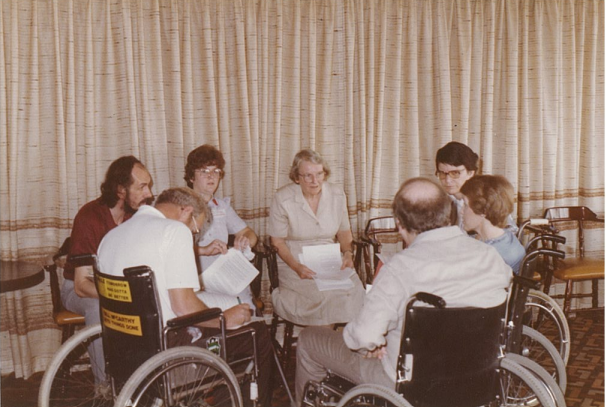
History of Australia’s disability
movement
Throughout history, people with disability have been ignored, hidden and cursed. When made visible, they have been subjects of exhibitions and objects of ridicule. Society has been ‘dealing’ with the ‘problem of people with disability by placing them in institutions or prisons and by sterilising women and girls as an acceptable treatment.
In 1908, the Australian Government introduced the Invalid Pension which increased the independence of people with disability as well as provided them with acknowledgment, to some extent, as recognised members of the society.
After the First World War and the return of many soldiers with impairments, the government funded rehabilitation programs. With the increased numbers of people with disability they all couldn’t be institutionalised and this demographic change acted as a step towards disability as a better recognised condition.
The consequences of the Second World War had a similar impact and strengthened the belief that people with disability have a right to lead decent lives. The Commonwealth Rehabilitation Service (CRS) was established and volunteer organisations extended their services to people with disability.
In the 1970s, people with disability who had professional qualifications and were working in the area of rehabilitation began a shift in Australian society from services provided to people with disability by people without disability only, to the involvement of people with disability interested in their own treatment and by extension, in their own movement.
Up until the late 1970s, the views of persons with disability were mainly filtered through the voices of disability service providers, professionals working in the area of disability and family members. This was also occurring at the international level. At the time, the key international disability organisation, Rehabilitation International, had a policy that while people with disability could attend its periodic international conference as observers, they were not permitted to speak. People with disability strongly protested against this policy at the 1980 conference of Rehabilitation International, held in Winnipeg, Canada, where a decision was made to establish a new international organisation of and for people with disability. The organisation founded was Disabled Peoples International, which now has members in over 160 countries throughout the world.

1981 was a turning point into the history of the Australian and international disability rights movements.
Disabled Peoples International held its first World Assembly in Singapore in the context of the International Year of Disabled Persons (IYDP) which had been declared by the United Nations. During this year, people with disability began to think of themselves more as a public issue rather than a private problem. The concept of systemic oppression also emerged as a motive for the development of a social movement in Australia and overseas. While, individuals and groups did advocate for the rights of people with disability before the IYDP, this action was mostly based around a medical diagnostic group or specific issue.
In 1981, disability became more than a diagnosis and something to be dealt with by medical professionals. People with disability discovered the social nature of their condition and became united in claiming self-determination and self-representation to overcome their social oppression as a group.
In 1986, disability rights advocacy was recognised as a programme area to be funded under the Disability Services Act 1986.
Since then, disability activism and advocacy began a sustained focus on several important cornerstones of disability self-determination; a general move away from institutional type services to community based services; relocation of people with physical disability from hostels and nursing homes into community housing, enlightened mental health legislation in various states, the establishment of ‘public advocates’ and guardianship boards in most states, the Disability Services Act 1986 (DSA) and the Disability Discrimination Act 1992 (DDA).
In 2008, the adoption and ratification by the Australian Government of the United Nations Convention for the Rights of Persons with Disabilities (CRPD) is the most recent major advancement of the Australian disability rights movement and in the lives of people with disability.
PWDA has extensive knowledge and understanding of the CRPD which is central to its work. During the CRPD development, PWDA participated in several of the UN Ad Hoc Committee meetings and undertook two consultative processes with people with disability throughout Australia. PWDA made over 32 interventions to the Ad Hoc Committee including the last meeting where the draft text was agreed. The final text of CRPD, in many aspects reflects the content of the consultation reports and interventions of PWDA systemic advocacy.
Ends | Contact us
Related content
Get involved
Become a member: Sign up now. It’s free!
Make a donation: Giving feels great!
Get our latest news: Straight to your inbox!

![PWDA-Services-5 - People with Disability Australia [IMAGE white line icon of three people]](/wp-content/uploads/2022/04/PWDA-Services-5-1320x743.png)
![PWDA-Services-8 - People with Disability Australia [IMAGE white line icon of a heart shape with a dollar sign in the centre]](/wp-content/uploads/2022/04/PWDA-Services-8-1320x743.png)
![PWDA-Services-6 - People with Disability Australia [IMAGE white line icon of newsletter with the word News in block letters]](/wp-content/uploads/2022/04/PWDA-Services-6-1320x743.png)